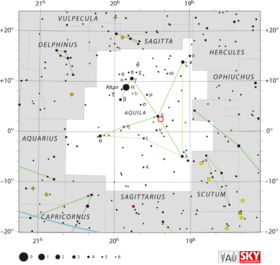Astronomy:V1370 Aquilae
| Observation data Equinox J2000.0]] (ICRS) | |
|---|---|
| Constellation | Aquila |
| Right ascension | 19h 23m 21.245s[1] |
| Declination | −02° 29′ 26.33″[1] |
| Apparent magnitude (V) | 6.0 – 20.0[2] |
| Astrometry | |
| Proper motion (μ) | RA: −3.433[1] mas/yr Dec.: −8.168[1] mas/yr |
| Parallax (π) | 0.4387 ± 0.1503[1] mas |
| Distance | 2928+3198 −450[3] pc |
| Characteristics | |
| Variable type | Nova[4] |
| Other designations | |
V1370 Aql, Gaia DR2 4288898099224201856,
2MASS J19232125+0229262 | |
| Database references | |
| SIMBAD | data |

V1370 Aquilae, also known as Nova Aquilae 1982, is a nova that appeared in the constellation Aquila during 1982. It was discovered by Minoru Honda of Kurashiki, Japan at 20:30 UT on 27 January 1982. At that time the Sun had moved just far enough from Aquila to allow the nova to be seen in the morning sky. Although it was discovered photographically, its apparent magnitude was 6–7, making it potentially visible to the naked eye under ideal conditions. A possible magnitude 20 progenitor was located on the Palomar Sky Survey prints. Spectra of the object were taken in February 1982 at Asiago Astrophysical Observatory, which confirmed that it is a nova.[5][4]
V1370 Aquilae faded rapidly after its discovery, and it had dimmed by three magnitudes in 13 days, making it a "fast" nova in the classification scheme of Cecilia Payne-Gaposchkin.[6][7] The light curve passed through a local minimum 43 days after the nova's discovery. That "dust dip", about 1 magnitude deep, resulted in the light curve being classified as type D.[8][9]
V1370 Aquilae erupted one year before the launch of the IRAS satellite, and it was detected by that satellite in the 12 and 25 micron bands.[10] The fading nova was also observed from the ground in the near and mid infrared by Bode et al., who concluded that either dust formed at an unusually early time in the nova event, or it was already present before the 1982 eruption occurred.[11]
All novae are binary stars, with a "donor" star orbiting a white dwarf. The stars are so close to each other that material is transferred from the donor to the white dwarf. In the case of V1370 Aquilae, Shara et al. estimated, based on the amplitude of the outburst and the rate of fading, that the mass of the white dwarf is 1.13M☉. Their models indicate that the white dwarf is accreting mass from the donor at a rate of 3.1 × 10−9 M☉ yr−1, and it will erupt as a nova every ~4000 years, after 1.29 × 10−5 M☉ of material has been accreted.[12] V1370 Aquilae is a "neon nova", a nova with a high mass white dwarf that ejects some of the white dwarf itself, along with the products of the thermonuclear runaway on the surface, during the nova event.[13][14]
References
- ↑ 1.0 1.1 1.2 1.3 1.4 Brown, A. G. A. (2021). "Gaia Early Data Release 3: Summary of the contents and survey properties". Astronomy & Astrophysics 649: A1. doi:10.1051/0004-6361/202039657. Bibcode: 2021A&A...649A...1G. Gaia EDR3 record for this source at VizieR.
- ↑ "V1370 Aql". AAVSO. https://www.aavso.org/vsx/index.php?view=detail.top&oid=2509.
- ↑ Schaefer, Bradley E. (December 2018). "The distances to Novae as seen by Gaia". Monthly Notices of the Royal Astronomical Society 481 (3): 3033–3051. doi:10.1093/mnras/sty2388. Bibcode: 2018MNRAS.481.3033S. https://ui.adsabs.harvard.edu/abs/2018MNRAS.481.3033S. Retrieved 15 January 2021.
- ↑ 4.0 4.1 4.2 Rosino, L.; Iijima, T.; Ortolani, S. (December 1983). "Light curve and spectral evolution of Nova Aquilae 1982". Monthly Notices of the Royal Astronomical Society 205 (4): 1069–1083. doi:10.1093/mnras/205.4.1069. Bibcode: 1983MNRAS.205.1069R.
- ↑ Kosai, H.; Honda, M.; Nishimura, S.; Ando, Y.; Okazaki, A.; Mattei, J.; Collins, P.; Morgan, J. (February 1982). "Nova Aquilae 1982". IAU Circular 3661: 1. Bibcode: 1982IAUC.3661....1K. https://ui.adsabs.harvard.edu/abs/1982IAUC.3661....1K. Retrieved 15 January 2021.
- ↑ Downes, R.A.; Duerbeck, H.W.; Delahodde, C.E. (December 2001). "Luminosities of [O III and Hydrogen Balmer lines in nova shells years and decades after outburst"]. The Journal of Astronomical Data (JAD) 7 (6): 6. Bibcode: 2001JAD.....7....6D. https://ui.adsabs.harvard.edu/abs/2001JAD.....7....6D. Retrieved 15 January 2021.
- ↑ Payne-Gaposchkin, Cecilia (1964). The galactic novae. New York: Dover. Bibcode: 1964gano.book.....P.
- ↑ Duerbeck, Hilmar W. (March 1987). "A Reference Catalogue and Atlas of Galactic Novae". Space Science Reviews 45 (1–2): 1–14. doi:10.1007/BF00187826. Bibcode: 1987SSRv...45....1D. https://ui.adsabs.harvard.edu/abs/1987SSRv...45....1D. Retrieved 15 January 2021.
- ↑ Strope, Richard J.; Schaefer, Bradley E.; Henden, Arne A. (July 2010). "Catalog of 93 Nova Light Curves: Classification and Properties". The Astronomical Journal 140 (1): 34–62. doi:10.1088/0004-6256/140/1/34. Bibcode: 2010AJ....140...34S.
- ↑ Harrison, T.E.; Gehrz, R.D. (September 1988). "A Survey of IRAS Data on 41 Classical Novae". Astronomical Journal 96: 1001. doi:10.1086/114860. Bibcode: 1988AJ.....96.1001H. https://ui.adsabs.harvard.edu/abs/1988AJ.....96.1001H. Retrieved 15 January 2021.
- ↑ Bode, M.F.; Evans, A.; Whittet, D.C.B.; Aitken, D.K.; Roche, P.F.; Whitmore, B. (April 1984). "Infrared photometry and spectrophotometry of Nova Aquilae 1982". Monthly Notices of the Royal Astronomical Society 207: 897–907. doi:10.1093/mnras/207.4.897. Bibcode: 1984MNRAS.207..897B.
- ↑ Shara, Michael M.; Prialnik, Dina; Hillman, Yael; Kovetz, Attay (June 2018). "The Masses and Accretion Rates of White Dwarfs in Classical and Recurrent Novae". The Astrophysical Journal 860 (2): 110. doi:10.3847/1538-4357/aabfbd. Bibcode: 2018ApJ...860..110S.
- ↑ Hachisu, Izumi; Kato, Mariko (January 2016). "Light-curve Analysis of Neon Novae". The Astrophysical Journal 816 (1): 26. doi:10.3847/0004-637X/816/1/26. Bibcode: 2016ApJ...816...26H.
- ↑ Truran, J.W.; Livio, M. (September 1986). "On the Frequency of Occurrence of Oxygen-Neon-Magnesium White Dwarfs in Classical Nova Systems". Astrophysical Journal 308: 721. doi:10.1086/164544. Bibcode: 1986ApJ...308..721T. https://ui.adsabs.harvard.edu/abs/1986ApJ...308..721T. Retrieved 15 January 2021.
 |


